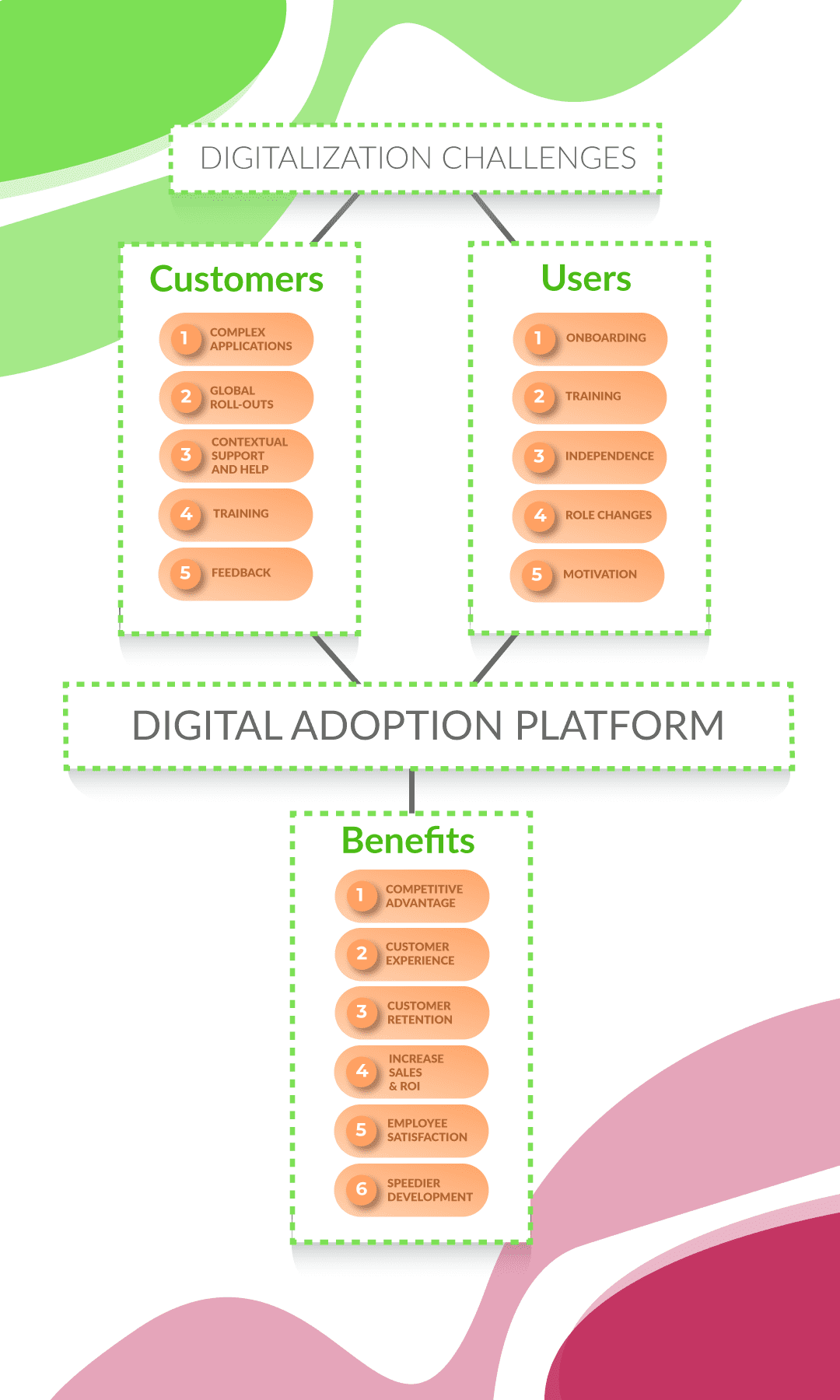Written by Frank Schroeder
Digital Adoption and Digital Adoption Platforms (DAPs) are ever more heard of, but what do they mean? This topic will be addressed from a company’s and an employee’s point of view, shedding light on the challenges and benefits offered by these solutions and why companies should consider using them.
Digitalization is the “mega trend”. At least for the past 2 years, Gartner has defined Digitalization as the use of digital technologies to change a business model and to provide new revenues and value-producing opportunities; it is the process of moving towards a digital business. Nobody will argue against this definition: it includes the transfer of paper, manual processes and business models into the digital sphere.
Digital Adoption now describes how far Digitalization has advanced in an organization, and Digital Adoption Platforms (DAPs) promise to help organizations with the execution of their digitalization initiatives.
While different vendors of DAPs define Digital Adoption differently, Lilach Bullock, a digital “Influencer”, brings it straight to the point when she states “that Digital adoption, quite simply, refers to achieving a state within your company where all of your digital tools and assets are leveraged to the fullest extend.”
DAPs
A digital adoption platform (DAP), in turn, “is a software layer integrated on top of another software application or website to guide users through tasks and functions. […]
These tools are also commonly used to train new employees on software used in-house.(G2 Growd) Recently, Gartner has established a new category, namely Digital Adoption Solutions, which considers the organization, platform and process aspects in its definition.
DAPs and the process of Digitalization
But how exactly can Digital Adoption Platforms or now, Digital Adoption Solutions, help with the process of digitalization?
To discuss and find an answer to this question, we can look at it from the company’s and the employee’s perspectives.
The challenges of digitalization for companies
In the process of Digitalization, Companies are faced with the following challenges:
- Complex Applications, as applications offer more and more possibilities (e.g. tasks, configuration, features), their complexity is increasing. Moreover, for some processes, customers need to use a set of applications to complete a single task;
- Constant change, companies need to react quickly/rapidly to market changes and needs and feel safe to adjust digital tools and processes as necessary;
- Customization, many of the enterprise digital tools are tailored and customized for particular deployments. Vendors often do not offer support to the implemented solutions and take care of generic platforms only.
- Global Roll-outs, international companies need to roll-out their applications worldwide, considering different cultures and languages;
- Contextual Support and Help, in a global world, customers face the challenge of getting 7×24 contextual support based on where the users have an issue within the application;
- Training, customers need a fast introduction to the application and continuous contextual training when they are using the application, especially when going through processes not required so frequently.
- Feedback for improvement, ongoing customer feedback is essential to speed-up the application development, improve user experience and the quality of the application
The challenges of digitalization for employees
Employees are faced with similar, yet slightly different challenges:
The challenges of increasing application complexity and contextual support & help are similar, but now seen from the user’s perspective. Other considerations emerge:
- Onboarding: this is an important topic for employees, as they need an efficient and fast onboarding process to become productive and integrate with the company’s processes asap.
- Training: Employees are required to master a great amount of content and processes, yet are usually offered old-fashioned training methods, which are proven to be ineffective for knowledge retention;
- Ability to work independently: employees are expected to be more and more self-reliable. Often, they are expected to make use of several digital resources effectively and without relying too much on external support – i.e. colleagues’ assistance or guidance by the company’s help desk.
- Role changes: employees are required to change roles more frequently than ever. The number of digital tools is growing and users could hardly follow the “train once” approach, but now they also need a continuous, ad-hoc support any time they get lost in the new use cases when they change positions.
- Motivation: employees are expected to grasp and follow the company’s digitalization, even if new technologies are not their cup of tea. They are expected to embrace change and keep motivated at the workplace.

DAPs and Digitalization
In order to be successful in the process of digitization, companies and organizations need to take care of the challenges they face and those faced by their employees. Using a Digital Adoption solution can help companies achieve the following benefits:
- Competitive Advantage, the user-friendliness of a company’s digital resources and the fast adaptation of internal and external applications bring a significant advantage to companies over their competitors. This is true both for companies who produce their own software for internal use or those who sell it to external customers, and in general in relation to a company’s rapport with its own employees.
- Customer experience, a unique customer experience beyond a design-driven user experience helps boost user enthusiasm and loyalty
- Customer Retention, customer enthusiasm and loyalty leads to a higher retention rate .It is not a secret that winning new customers is expensive – losing customers at a time when we need to win new customers is even more expensive, and represents a high risk for the future and the sustainable growth of a company;
- Increase Sales & ROI, an effective application adoption will lead to an increase in sales and to a solid ROI
- Employee Satisfaction, contextual in-app support and user guidance will increase employee satisfaction and guarantee a low fluctuation rate· Fast development, continuous interaction and feedback by the application users allows companies to speed up the application development in an agile way and to increase the quality and user experience of their applications
Digital Adoption Platforms or Solutions can play a key role to address the challenges and provide this benefit to companies, customers and users. Find out how our DAS can help your company!


